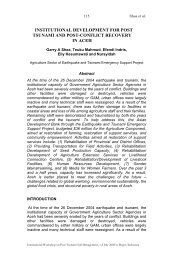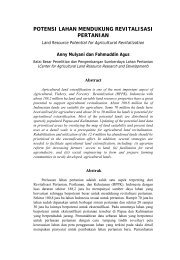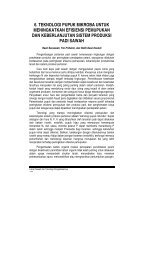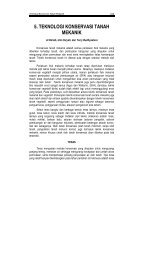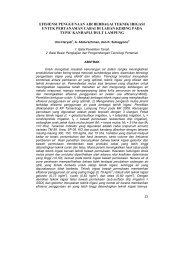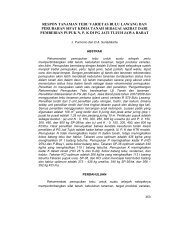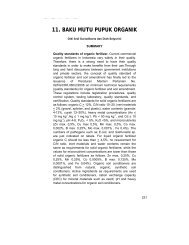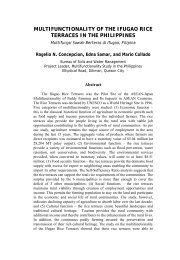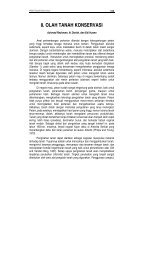Proceedings - Balai Penelitian Tanah
Proceedings - Balai Penelitian Tanah
Proceedings - Balai Penelitian Tanah
Create successful ePaper yourself
Turn your PDF publications into a flip-book with our unique Google optimized e-Paper software.
139<br />
Wahyunto et al.<br />
2004 (before the Tsunami) and Landsat-7 taken on 29-30 December<br />
2004 and January 2005 (after the Tsunami), IKONOS and SPOT<br />
(after tsunami). (2) Topographic maps available for the whole of study<br />
areas at 1:50.000 scale printed by Bakosurtanal in 1975-1995. (3)<br />
Land Unit and Soil Maps of Takengon sheet at 1:250,000 scale (Darul<br />
Sukma et al., 1990), covering the whole districts of Aceh Barat.<br />
Physiographic region or land unit delineation was based on physical<br />
characteristics phenomenon such as: parent material, soil drainage,<br />
slope steepness, natural land use etc. Boundaries of land units were<br />
generated based on analysis of Digital SPOT-5 image and designed<br />
to match with topographic map at scale 1:50,000. The elineation of<br />
land units which could be used as mapping unit occurred by means on<br />
screen digitising. Landsat TM-5 digital image was also used to provide<br />
additional information. Although the initial analysis were mainly<br />
morphological and lithological, these may already take account of<br />
information on soils. The interpretation and analysis refers to the<br />
Guidelines for Landform Classification ( Dessaunettes J.R., and J.F.<br />
Harop.1975; Buurman et al., 1990 and Marsoedi Ds et al., 1997). This<br />
interpretation has to be checked in the field and, in addition, data on<br />
soils and the relation between soil and landscape have to be<br />
gathered. The content of each soil mapping unit especially on soil<br />
characteristics has to be established. Ideally, each physiographic<br />
mapping unit with development potential should be covered by one or<br />
more sample areas/ lines. Therefore, areas (sampling) that have no<br />
potential especially for agricultural crops (including tree crops and<br />
food crops) such as mountainous and forested conservation areas,<br />
should be kept at a minimum. Areas with lack of accessibility such as<br />
rugged terrain, deep peat, and forested conservation areas, were<br />
based on very limited field checks and mainly based on image<br />
interpretation and extrapolation.<br />
During field observations, all major landscapes were studied, either<br />
by cross sections or by random observations. Soils representing the<br />
physiographic mapping unit were described in profile minipits and<br />
sampled for laboratory analysis. All field descriptions of profile minipits<br />
and cores were coded on special forms that were developed in<br />
advance. Coding from these forms were stored in computer format.<br />
The field observations were based on the Guidelines for soil<br />
observation in the field prepared by ISRI (2004), and Guidelines for<br />
Soil Profiles Description (FAO, 1974). Soil Classification at sub-group<br />
level was based on the Keys to Soil Taxonomy (Soil Survey Staff,<br />
2003).<br />
Soil characteristics were studied: depth of soil horizons (soil layers),<br />
the smelt of sulfidic material (if any), color of soil matrix and their<br />
mixture, soil textures, soil ripeness, soil pH measured with pH meter,<br />
and crops performance. Soil sample of 1 kg from first (top layer) and<br />
International Workshop on Post Tsunami Soil Management, 1-2 July 2008 in Bogor, Indonesia



